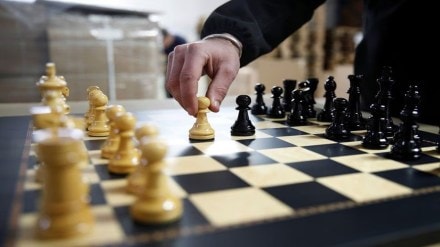This is a time when several successes have converged, on the moon and on earth. On earth, there have been sporting successes for India—in wresting, boxing, weightlifting, shooting, badminton, hockey, and chess. In recent weeks, Neeraj Chopra, Gukesh Praggnanandhaa, Arjun Erigaisi, and Nihal Sarin have become household names, perhaps even Raunak Sadhwani and Koneru Humpy. Though public memory is short, these successes and role models have positive externalities, probably more for chess than for track and field, simply because the paraphernalia required for chess is simpler. This is a bit like the Vishwanathan Anand effect in India, or the Bobby Fisher effect in general. I wonder what Mahesh Chandra Banerjee would have made of this. I doubt if that name will ring a bell, even among chess aficionados.
Chess, in some form, no doubt originated in India. Descriptions of battles in texts say armies were chaturanga. This means an army had four kinds of forces—infantry, cavalry, elephants, and chariots. Pawns constitute infantry. They are foot-soldiers. Cavalry are today’s knights. Today, all chess sets are standardised. They are known as Staunton sets, name after Howard Staunton. At the time, in 1840s, there were no proper world championships. We will never know whether Staunton was the strongest player in the world in 1840s, but he was certainly Europe’s strongest player. Staunton didn’t design those sets. They were designed by Nathaniel Cooke, a journalist, who immediately registered his design with the British Patent Office in 1849. This is in line with Alfred Collier getting a patent on Ludo in 1891, though Ludo-like games were played in India for thousands of years.
The knights in the Cooke-Staunton design were no doubt influenced by Europe’s medieval knights. In old unpatented chess sets from India, knights are different. (There are regional variations though.) The horse and the rider can be distinctly identified. The pieces do resemble infantry. The elephant and the rider are also distinct in the piece that has become the bishop today. We don’t quite know how the elephant became a bishop, as the game transited through Persia. There is a convoluted explanation about stylised tusks reminding people about a bishop’s mitre. Similarly, clearly identifiable chariots became rooks, resembling towers of medieval European forts. Let’s skip transitions of the king and mantri (queen). Thousands of years ago, we don’t know whether the game then referred to as chaturanga was played by two players or four (with pieces distributed among four players). Nor do we know for sure whether references to an ashtapada board (eight by eight) was to chess or something else. An akshauhini is an army and, as in the Kurukshetra War, each side could possess many akshauhinis. One akshauhini consisted of 21,870 chariots, 21,870 elephants, 65,610 horses and 109,350 foot-soldiers. To state what isn’t always obvious, each of those numbers, with the digits added, has a total of eighteen. The chariot/elephant/horse/infantry ratio is 1/1/3/5.
When a beginner learns to play chess, the beginner is taught a bishop or a knight is equal to three pawns, while a rook is equal to five, though actual worth depends on position on the board. Though it breaks down a bit for elephants (there were plenty of elephants in India), the coincidence is remarkable. Just as chess sets have become standardised, so have rules. When we were kids, we often encountered chess with “Indian” rules. There was no en passant, pawns on the second rank could move only one square. Pawns were promoted to whatever piece occupied that file, without a choice. To start with, each side had two moves. There was no castling. The king’s knight (rarely the queen’s) pawn was pushed up one square, to make way for the bishop (known as fianchetto). Before being checked, the king had one knight’s leap. In absence of castling, that’s how one protected the king. Lest I forget, when starting, the queen was to the left of the king. (It made a difference for black). These rules lead to closed positions and more draws. In closed positions, knights are more valuable than bishops and players under Indian rules were adept at handling knights. Every beginner will be taught to occupy the centre and will later be told about hypermodern systems and attacking from a distance. They will be taught defences (and attacks) like King’s Indian, Queen’s Indian, and Grunfeld, involving a fianchettoed bishop. Under the old “Indian” rules, you couldn’t occupy the centre. You attacked from a distance. With rules standardised, I suspect the current crop of chess players may not know of these antecedents. The Grunfeld Defence is named after Ernst Grunfeld, who played it in 1922. Decades earlier, it was played by Mahesh Chandra Banerjee. Who was he?
One of Staunton’s proteges was John Cochrane, a very strong chess player, second to Staunton within Britain (The Cochrane gambit is named after him). His work brought him to India (Kolkata) and looking around for a strong chess player, he discovered Mahesh Chandra in a village in Hooghly. Played between 1848 and 1860, according to international rules, almost 450 games have been preserved in databases. Draws apart, Cochrane won twice as many games as Mahesh Chandra. But without training and with natural talent alone, Mahesh Chandra’s feat was quite remarkable. The current young crop is amazing. But there were predecessors, not only Anand and Manuel Aaron, but going back further, Mian Sultan Khan and Mahesh Chandra Banerjee.
Bibek Debroy, chairman, EAC-PM. Views are personal.
